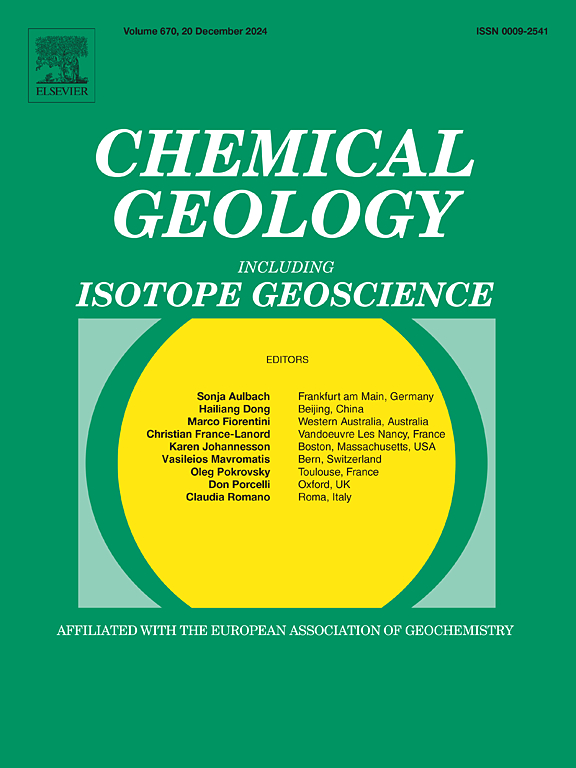Ni、Cu和Fe同位素在矿床成因指示中的应用——来自芬兰拉普兰Rajapalot金[sbnd]Co远景区的新认识
IF 3.6
2区 地球科学
Q1 GEOCHEMISTRY & GEOPHYSICS
引用次数: 0
摘要
稳定过渡金属同位素作为矿石成因指标的应用越来越受欢迎,但对这些非常规体系的分馏机制和同位素分布仍知之甚少。在本研究中,我们采用多收集器ICP-MS分析了从溶液中测量的硫化物Ni, Cu和Fe同位素。数据收集于芬兰拉普兰Rajapalot AuCo矿床中Raja远景区的显性硫化物相。我们的主要目标是获得有关高温成矿环境中同位素的系统和行为的新信息,并对矿床成因产生影响。拉加远景区为古元古代火山-沉积层序,是由西芬系造山运动多期热液作用形成的。黄铁矿δ56Fe变化显著(-2.08 ~ +3.29‰),是迄今为止在天然黄铁矿中观测到的最重的铁同位素。磁黄铁矿的δ56Fe值变化较小(-0.74 ~ +0.80‰),但与岩浆磁黄铁矿相比,δ56Fe值异常重。黄铜矿δ56Fe值为+0.10 ~ +1.45‰,磁黄铁矿δ60Ni值为-1.03 ~ +0.18‰,黄铜矿δ65Cu值为-0.30 ~ +0.23‰。共存硫化物相的δ56Fe值显示了平衡分馏和动力学分馏效应。铁在黄铁矿中的极端分馏表明动力学分馏在同位素轻黄铁矿的沉淀中起主要作用。此外,低δ56Fe值可能继承自磁黄铁矿前体。部分磁黄铁矿和黄铁矿的重铁同位素组成可能是后期热液优先浸出轻同位素的结果。本文章由计算机程序翻译,如有差异,请以英文原文为准。
Application of Ni, Cu and Fe isotopes as indicators of ore genesis - New insights from the epigenetic-hydrothermal Rajapalot AuCo prospect, Finnish Lapland
Application of stable transition metal isotopes as indicators of ore genesis is becoming more popular, yet the fractionation mechanisms and isotopic distribution in these unconventional systems remain poorly understood. In this study, we present an analysis of sulphide Ni, Cu and Fe isotopes measured from solution using multicollector ICP-MS. The data were collected from the dominant sulphide phases in the Raja prospect within the epigenetic-hydrothermal Rajapalot Au![]() Co deposit, Finnish Lapland. Our main goal was to gain new information on the systematics and behaviour of the isotopes in high-temperature ore-forming environments, with implications for ore genesis. The Raja prospect is hosted by a Paleoproterozoic volcanic-sedimentary sequence and was formed by multi-stage hydrothermal processes during the Svecofennian orogeny. Pyrite shows significant variation in δ56Fe (-2.08 to +3.29 ‰), including the heaviest iron isotopes thus far observed in natural pyrite. The δ56Fe values in pyrrhotite vary less (-0.74 to +0.80 ‰) but are unusually heavy compared to those of magmatic pyrrhotite. δ56Fe in chalcopyrite ranges from +0.10 to +1.45 ‰, δ60Ni in pyrrhotite from -1.03 to +0.18 ‰, and δ65Cu in chalcopyrite from -0.30 to +0.23 ‰. The δ56Fe values in co-existing sulphide phases suggest both equilibrium and kinetic fractionation effects. The extreme Fe fractionation in pyrite implies that kinetic fractionation played a major role in the precipitation of isotopically light pyrite. Moreover, inheritance of low δ56Fe values from a pyrrhotite precursor is likely. The heavy Fe isotopic composition of some of the pyrrhotite and pyrite is probably the result of preferential leaching of light isotopes by late hydrothermal fluids.
Co deposit, Finnish Lapland. Our main goal was to gain new information on the systematics and behaviour of the isotopes in high-temperature ore-forming environments, with implications for ore genesis. The Raja prospect is hosted by a Paleoproterozoic volcanic-sedimentary sequence and was formed by multi-stage hydrothermal processes during the Svecofennian orogeny. Pyrite shows significant variation in δ56Fe (-2.08 to +3.29 ‰), including the heaviest iron isotopes thus far observed in natural pyrite. The δ56Fe values in pyrrhotite vary less (-0.74 to +0.80 ‰) but are unusually heavy compared to those of magmatic pyrrhotite. δ56Fe in chalcopyrite ranges from +0.10 to +1.45 ‰, δ60Ni in pyrrhotite from -1.03 to +0.18 ‰, and δ65Cu in chalcopyrite from -0.30 to +0.23 ‰. The δ56Fe values in co-existing sulphide phases suggest both equilibrium and kinetic fractionation effects. The extreme Fe fractionation in pyrite implies that kinetic fractionation played a major role in the precipitation of isotopically light pyrite. Moreover, inheritance of low δ56Fe values from a pyrrhotite precursor is likely. The heavy Fe isotopic composition of some of the pyrrhotite and pyrite is probably the result of preferential leaching of light isotopes by late hydrothermal fluids.
Systematic correlations between the composition of the examined isotope systems, Co and Au concentrations, and textural features link the sulphide isotopes to multi-stage ore formation. Gradual trends in the isotope compositions suggest Rayleigh fractionation. Early Co deposition is attributed to isotopically heavy fluid, probably derived from a sedimentary formation with abundant iron oxides. The isotopically lighter Au mineralising fluids point to a separate fluid source, probably involving evolved granites. The late hydrothermal Au-carrying fluids overprinted the early Co mineralisation forming Au![]() Co enriched zones. Our study highlights the potential of multiple isotope systematics in sulphides as a useful diagnostic tool for tracing mineralisation processes in and source regions of hydrothermal Au and Co.
Co enriched zones. Our study highlights the potential of multiple isotope systematics in sulphides as a useful diagnostic tool for tracing mineralisation processes in and source regions of hydrothermal Au and Co.
求助全文
通过发布文献求助,成功后即可免费获取论文全文。
去求助
来源期刊

Chemical Geology
地学-地球化学与地球物理
CiteScore
7.20
自引率
10.30%
发文量
374
审稿时长
3.6 months
期刊介绍:
Chemical Geology is an international journal that publishes original research papers on isotopic and elemental geochemistry, geochronology and cosmochemistry.
The Journal focuses on chemical processes in igneous, metamorphic, and sedimentary petrology, low- and high-temperature aqueous solutions, biogeochemistry, the environment and cosmochemistry.
Papers that are field, experimentally, or computationally based are appropriate if they are of broad international interest. The Journal generally does not publish papers that are primarily of regional or local interest, or which are primarily focused on remediation and applied geochemistry.
The Journal also welcomes innovative papers dealing with significant analytical advances that are of wide interest in the community and extend significantly beyond the scope of what would be included in the methods section of a standard research paper.
 求助内容:
求助内容: 应助结果提醒方式:
应助结果提醒方式:


